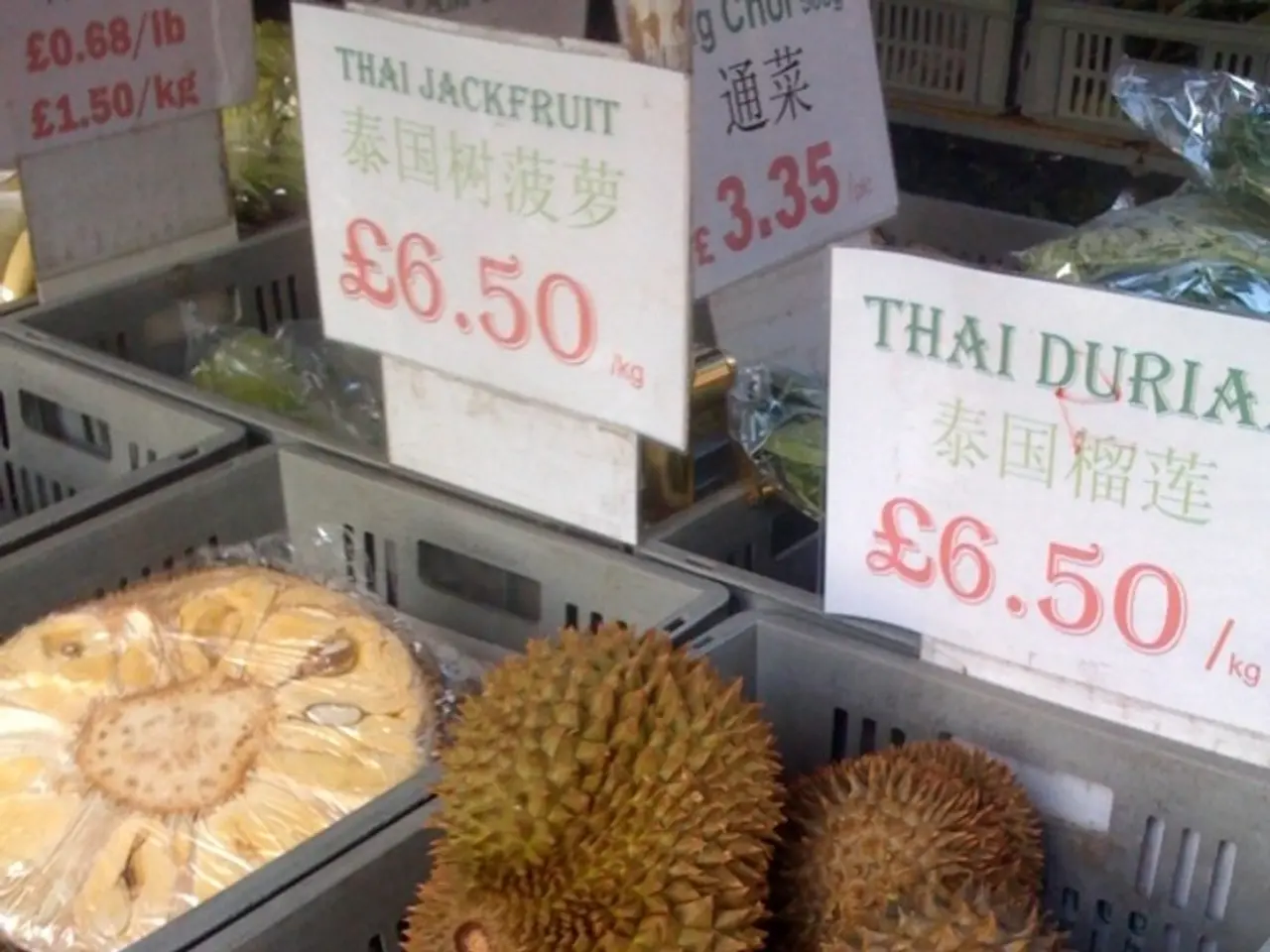Seasonal Jamun Fruit Offers Antidiabetic Properties and Financial Gains for Farmers
India's small farmers, particularly those in flood-prone or low-fertility regions, are finding a climate-resilient and lucrative crop in Jamun (Syzygium cumini L. Skeels), also known as Jambul, Java plum, or black plum. This native Indian fruit tree offers a host of benefits, making it a promising option for improving livelihoods in vulnerable agricultural regions.
Jamun trees are renowned for their adaptability and resilience. They are drought-resistant and can thrive in Indian tropical climates with relatively low maintenance. The trees grow well in diverse conditions, including poor or low-fertility soils, making them suitable for marginal lands often affected by floods or nutrient depletion.
One of the key advantages of Jamun cultivation is its flood resilience. Though specific flood tolerance data isn't available, Jamun's robustness and ability to grow in various Indian conditions suggest it can be integrated into agroforestry models in flood-prone areas to improve land use and stability. Moreover, the tree requires minimal external inputs once established, reducing costs for small farmers compared to more input-intensive crops.
Besides fruit production, Jamun trees improve biodiversity and can be grown in home gardens or farms, offering ecological benefits and enhancing farm resilience. The fruit itself is rich in moisture (approximately 84%), 14 grams of carbohydrates, fiber, essential minerals, and vitamins.
Potential income opportunities from Jamun farming are substantial. Recently, India achieved a milestone by exporting fresh Jamun to international markets like the UK, with farmers in Karnataka fetching nearly ₹110 per kg, which is almost double the typical domestic price of ₹50–60 per kg. Jamun fruit is versatile—it can be consumed fresh or processed into jams, syrups, wines, and medicinal powders. This opens opportunities for small farmers or Farmer Producer Organizations (FPOs) to diversify income through value addition.
Jamun is renowned for its health benefits, particularly in managing blood sugar and digestion, which supports market demand in both domestic and export health-conscious consumers. The expansion into export markets, supported by government initiatives like APEDA and ‘Vocal for Local,’ enhances income prospects for Jamun growers by connecting them to premium international markets willing to pay higher prices.
Furthermore, the seeds of Jamun contain jamboline and jambosine, natural alkaloids effective in balancing blood sugar levels. Jamun seed powder is marketed as a health supplement for diabetics online and in pharmacies. The unique bioactive contents of flavonoids, tannins, phenols, alkaloids, and anthocyanins present in Jamun work as antioxidants, anti-inflammatory, and immune systems' boosters.
Small processing units can generate 3-5 times more revenue compared to raw fruits for farmer producer organizations (FPOs) or self-help groups (SHGs). Government programs and Krishi Vigyan Kendras (KVKs) can encourage Jamun cultivation through training, seedling supply, and buy-back assurance.
In summary, Jamun cultivation can provide small farmers in flood-prone or low-fertility areas with a climate-resilient, low-input crop that enhances farm sustainability while opening up lucrative income streams through fresh fruit sales and value-added products, including export opportunities. This makes Jamun a promising option for improving livelihoods in vulnerable agricultural regions of India.
Moreover, farmer groups can collaborate on branding, packaging, and GI labeling of local Jamun types for the health-aware urban market. Jamun vinegar, wine, and candies are produced as value-added products. Jamun wood is termite-resistant and suitable for furniture, farm tools, and rural housing, providing additional income streams.
In conclusion, Jamun is a natural treasure that can combat disease and poverty simultaneously, providing a low-cost solution for diabetes and lifestyle diseases. Indian farmers, particularly those with poor land conditions, can benefit from Jamun cultivation as a new avenue to sustainable income and climate-resilient agriculture.
- The adaptability and resilience of Jamun trees make them a promising option for improving livelihoods in vulnerable agricultural regions.
- Jamun trees are drought-resistant and can thrive in Indian tropical climates with relatively low maintenance.
- The trees grow well in diverse conditions, including poor or low-fertility soils, making them suitable for marginal lands often affected by floods or nutrient depletion.
- One of the key advantages of Jamun cultivation is its flood resilience, suggesting it can be integrated into agroforestry models in flood-prone areas.
- Jamun requires minimal external inputs once established, reducing costs for small farmers compared to more input-intensive crops.
- Besides fruit production, Jamun trees improve biodiversity and can be grown in home gardens or farms.
- The fruit itself is rich in moisture, carbohydrates, fiber, essential minerals, and vitamins.
- Potential income opportunities from Jamun farming are substantial, with farmers in Karnataka fetching nearly ₹110 per kg for exports.
- Jamun fruit can be processed into jams, syrups, wines, and medicinal powders, providing opportunities for small farmers or Farmer Producer Organizations (FPOs) to diversify income through value addition.
- Jamun is renowned for its health benefits, particularly in managing blood sugar and digestion, which supports market demand.
- The expansion into export markets, supported by government initiatives like APEDA and ‘Vocal for Local,’ enhances income prospects for Jamun growers.
- The seeds of Jamun contain jamboline and jambosine, natural alkaloids effective in balancing blood sugar levels.
- Jamun seed powder is marketed as a health supplement for diabetics online and in pharmacies.
- The unique bioactive contents of flavonoids, tannins, phenols, alkaloids, and anthocyanins present in Jamun work as antioxidants, anti-inflammatory, and immune systems' boosters.
- Small processing units can generate 3-5 times more revenue compared to raw fruits for farmer producer organizations (FPOs) or self-help groups (SHGs).
- Government programs and Krishi Vigyan Kendras (KVKs) can encourage Jamun cultivation through training, seedling supply, and buy-back assurance.
- Farmer groups can collaborate on branding, packaging, and GI labeling of local Jamun types for the health-aware urban market.
- Jamun vinegar, wine, and candies are produced as value-added products.
- Jamun wood is termite-resistant and suitable for furniture, farm tools, and rural housing, providing additional income streams.
- Jamun cultivation can provide small farmers in these regions with a climate-resilient, low-input crop that enhances farm sustainability.
- This makes Jamun a promising option for improving livelihoods in vulnerable agricultural regions of India.
- Collaboration among farmers, government, and the private sector can boost the growth of the Jamun industry in India.
- The health benefits of Jamun can help combat disease and poverty simultaneously, providing a low-cost solution for diabetes and lifestyle diseases.
- Investments in research and development of Jamun farming can lead to improved yield and quality, further enhancing its appeal to farmers and consumers alike.
- The Jamun cultivation can also contribute to environmental sustainability, as it helps combat climate change by absorbing carbon dioxide and promoting biodiversity.
- The Jamun industry can create employment opportunities in rural areas, boosting local economies and reducing migration to urban centers.
- The Jamun industry can also develop sustainable manufacturing processes, adhering to best practices in energy efficiency, waste management, and pollution control.
- The growth of the Jamun industry can lead to wider social impacts, such as improving healthcare services, promoting education, and supporting community development in rural India.




